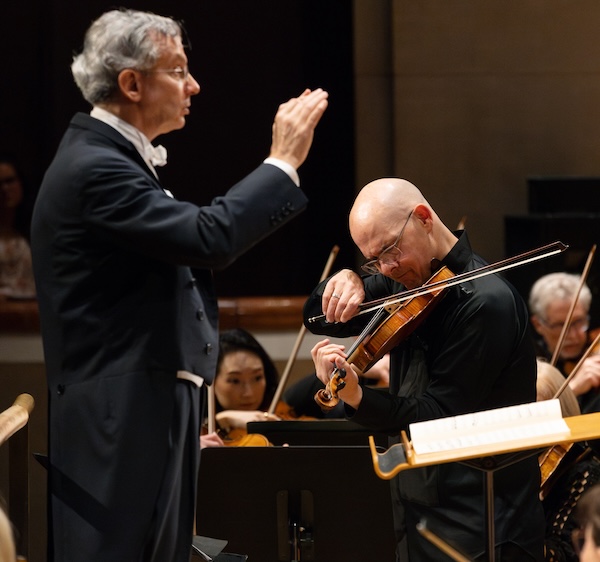Luisi and DSO offer a compelling premiere, engaging Bruch and breathless Beethoven

The Dallas Symphony Orchestra toggles this weekend from the newest of the new to the most familiar of all.
The evening opened with a world premiere, Inscription for Orchestra by Raven Chacon. The Pulitzer Prize winning indigenous composer is known for unusual instrumentation; among his oeuvre is a piece for firearms and foghorns, for which he had to develop a notation system that non-musician shooters and sea captains could read.
Inscription uses only instruments found in the traditional orchestra. The 15-minute work begins with sustained microtonal notes in the bass clarinet, bass trombone, and muted trumpet that become pulses of sound. The piece explores the extreme ranges of many instruments—the lowest notes on the double bass extensions and on the piano, the highest strings of the harp. Chacon also employs extended techniques (think Penderecki or Ligeti) such as, in the strings, left hand glissandos while making circles with the bow.
Fabio Luisi guided the Dallas musicians skillfully through this avant-garde journey, and the overall effect was a mesmerizing soundscape in this DSO co-commissioned debut.
The week has been a small Dallas celebration of Raven Chacon’s work. On Tuesday evening, the DSO sponsored a concert featuring Chacon’s Pulitzer-Prize-winning work, Voiceless Mass, performed by students from SMU, members of the Dallas Symphony Chorus, and DSO organist Bradley Hunter Welch, and conducted by principal percussionist George Nickson.
The remainder of the Dallas Symphony’s program this weekend is far more conventional. Concertmaster Alexander Kerr’s rendition of the Bruch Violin Concerto No. 1 highlighted the best things about his playing: precise technique, warm tone, and lush vibrato that is just right for a Romantic concerto.
Under Luisi’s direction, the orchestra responded to Kerr’s warmth in kind: this was a loving interpretation of a favorite concerto, beginning with that first, famous open G in the solo violin. Kerr kept tempos moving, including in the middle movement, never letting the music bog down. He has the technique to take even the brisk final movement at whatever pace he wishes, and he zipped along to a virtuosic exciting finish.
While Kerr’s playing was never too fast, the same cannot be said for Luisi’s performance of Beethoven’s Symphony No. 5, which was both too fast and too loud.
It is, of course, difficult for a conductor to say anything new in a performance of a piece as familiar as this one. The opening to the first movement is probably the best-known theme in all of orchestral music. But while “fast” and “loud” for their own sakes are admirable qualities in, say, a Lamborghini, they are not as desirable in Beethoven.
Fortes became fortissimos almost without trying, and true pianissimos were rarely in evidence. The symphony is invariably dramatic, so fudging dynamics a bit makes some sense and may be what many audience members want to hear. The tempos accelerated through each movement until by the finale it was astonishing that the musicians could continue to play cleanly—but they did.
The audience seemed thrilled, including some folks in the balcony who were determined to applaud loudly between each movement, even over the beautiful viola and cello melody at the beginning of the second movement.
Amid this dizzying land-speed record test, the Andante con moto was the highlight. When the second violins floated that glorious lush tune that is introduced by the violas and cellos, it provided a bright spot in an otherwise rushed interpretation of an iconic work.
The program will be repeated 7:30 p.m. Saturday and 3 p.m. Sunday. dallassymphony.org